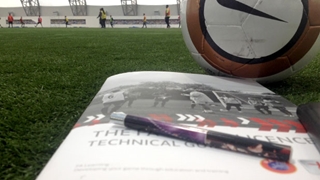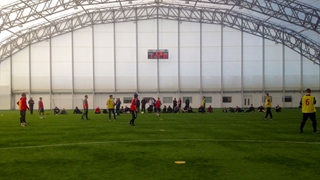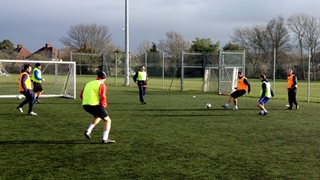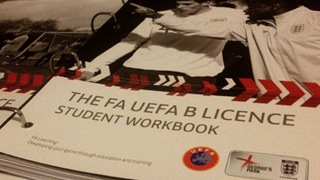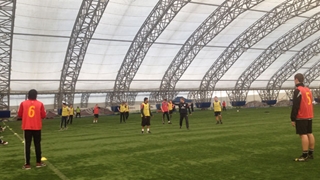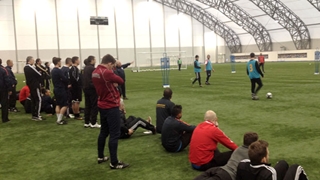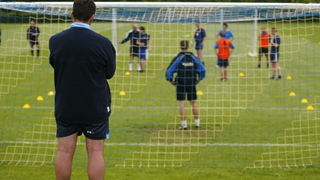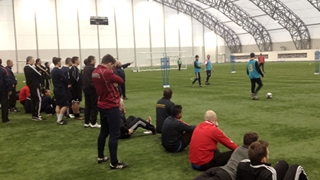
FA Editor Jamie Bradbury has taken his next steps along the coaching pathway and is now working towards the UEFA B coaching licence.
Day seven focused on counter-attacking while students got another chance to coach...
Having already been issued with our topics for the second session we must each deliver, I spent the evening considering how I was going to approach 'a phase of play coaching a team to defend in its own half'.
We were due to find out when we were to deliver our sessions when we arrived for day seven, so it was important to prepare and produce our plans in case we were first up.
The chat around the classroom at the London Soccerdome when I got there was inevitably of the practices everyone would deliver. As I've mentioned in the previous blogs, there are 48 of us on the course, split into four smaller tutor groups, and it was in those that we delivered our first practical a month before.
This time, and all remaining sessions we must do, will be in two groups of 24, so over the next three days we knew we'd have to get through an average of eight student sessions, as well as the tutor sessions, each day. So there was going to be a lot of football action for us.
Jon Gittens (course director) opened up the day's activities by giving each tutor 12 a topic to plan, just to get people used to doing them as there are a lot we need to produce - and deliver - in our student packs. Around 25 sessions all together.
We were given a functional practice - playing in central positions - so the first thing we needed to consider was which players we'd use and therefore which area of the pitch we would focus on.
Ted Dale's (tutor) rule of thumb on drawing up functional practices is quite simple; divide the pitch lengthways into six equal zones, take away the two furthest zones from where your practice is focused and that gives you the playing area.
Then position the players realistically in that area, which will allow you to leave some positions out, concentrating on the part of the pitch you are interested in. In our case it was the central area, so we eliminated to two widest zones.
After we'd discussed our plans within the group, we were then given the running order for our sessions. I found out that I'd not be on until tomorrow, so could throw myself into the three tutor and seven student practices that were on the agenda.
Out on the pitch, the main topic for the day was counter-attacking, and Ed, Richard and Ted (tutors) each delivered a session from the syllabus, one of which I've drawn up using The FA Coach's App.
Counter-attacking and winning the ball back
Skill Practice - click to download pdf created with The FA Coach's App
This was a simple practice set-up, a 30x30 square with goals in each corner, 4v2 with four players on the outside supporting the two in the middle. The four in the middle started as defenders and it was their job to win possession and attack one of the goals quickly. So the primary concern for the four was to defend well. Good counter-attacking is built on a solid base of defending - if you can't win the ball back, then up you can't counter.
Defend deep to counter-attack
Small-Sided Game
Again, this time in a standard small-sided game, Richard emphasised the principles of defending. While managing the opposition to ensure they played realistically, Richard worked on his team to initially win the ball back and react quickly and spot opportunities to get their opposition out of balance.
Counter-attacking
Phase of Play
I decided to take part in Ted's practice, and operated on the left wing. Though comfortable on my left, I'm naturally right-footed and when I received a pass out wide, I took two touches, first to control, then to get the ball in front of me in a good position to deliver a cross. It wasn't too bad, but Ted stopped play to re-create the situation and suggested, as a counter-attacking team, I took just one touch, or none, before crossing to get the defence out of balance. And that's the key. If you don't do things quickly enough, the counter becomes less effective.
After a spot of lunch, we were back out on the pitch for seven 25-minute student sessions, which were;
- Functional Practice: Coach a full-back to defend in wide positions in defending half of the field (James)
- Functional Practice: Coach two centre-backs to defend against two strikers who show clever movement (Michael)
- Functional Practice: Coach midfield players to move into goal scoring positions in the box (Matt)
- Functional Practice: Coach strikers to play against a tight-marking centre backs (Kwasi)
- Phase of Play: Coach a team to defend against counter-attacks (Terry C)
- Phase of Play: Coach a team to produce and score from crosses (Terry B)
- Small-Sided Game: Coach a team when to pass and when not to pass forwards (Kyriacos)
All the session were well-delivered and showed progress from the first block, but it was a tiring afternoon and energy levels did begin to drop.
However, the final session with five-o'clock approaching was Kyriacos's small-sided game, which we split into teams based on our tutor groups - that sparked a bit of rivalry and got everyone fired up. Like being back at school!
That wrapped up day seven, and I knew I was on for my session the next day, so overnight was able to put some final touches on my plan. I'm looking forward to doing some coaching myself now, it's why we're there after all.
Keep checking TheFA.com for more from the UEFA B course. If you have any questions you can follow Jamie on Twitter @jamiebradbury.
To find out more about local coaching courses, visit your County FA website, or for national courses click here.
www.footballcommunion.com





